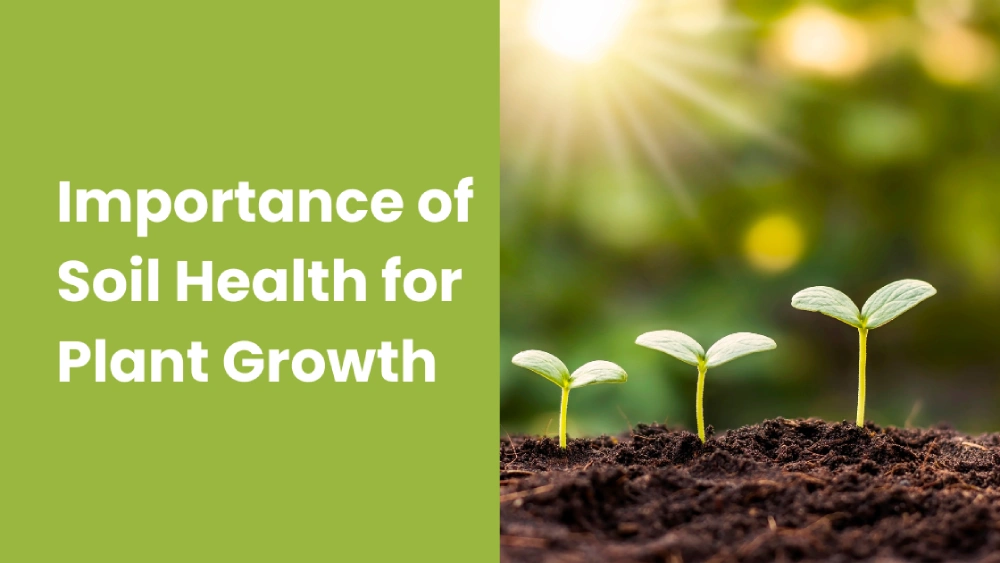Soil health is a fundamental aspect of successful plant growth and agricultural productivity. As a planting coach, understanding the importance of soil health is crucial for optimizing plant growth and ensuring sustainable practices. Soil health refers to the overall well-being and fertility of the soil, encompassing various factors such as nutrient content, pH levels, structure, and microbial activity.
In this blog post, we will delve into the significance of soil health for plant growth, exploring its role in providing essential nutrients, supporting root development, and fostering a conducive environment for beneficial soil organisms. By understanding soil composition and its impact on plant health, we can implement effective strategies to improve soil fertility and maximize crop yields.
Let’s explore the importance of soil health and discover how it lays the foundation for vibrant and productive ecosystems.
Soil Composition
Soil composition is a complex interplay of various components that collectively contribute to its health and fertility. These components include minerals, organic matter, water, and air, each vital in supporting plant growth and ecosystem functioning.
Minerals form the inorganic fraction of soil and originate from the weathering of rocks and minerals over time. They provide essential nutrients such as nitrogen, phosphorus, and potassium, which are crucial for plant metabolic processes. The mineral composition of soil varies depending on factors such as parent material, climate, and geographical location.
Soil Nutrients and Their Role
Soil nutrients are essential elements that plants require for various physiological functions and growth processes. Understanding their role in soil health is crucial for optimizing plant growth and productivity.
1. Nitrogen (N):
- Nitrogen is a primary component of amino acids, proteins, and chlorophyll. It is essential for plant growth and photosynthesis.
- It plays a key role in promoting leafy green growth and the development of stems and branches.
- Nitrogen deficiency can result in stunted growth, yellowing of leaves (chlorosis), and reduced yield. Excess nitrogen, however, can lead to excessive vegetative growth at the expense of fruit or flower production.
2. Phosphorus (P):
- Phosphorus is involved in energy transfer and storage within plants, as well as the formation of DNA, RNA, and cell membranes.
- It is crucial for root development, early plant growth, and flowering.
- Phosphorus deficiency can manifest as slow or stunted growth, purplish discoloration of leaves, and poor root development. Adequate phosphorus levels are particularly important during the early stages of plant growth.
3. Potassium (K):
- Potassium regulates water uptake, osmotic balance, and enzyme activation within plants.
- It enhances drought tolerance, disease resistance, and overall plant vigor.
- Potassium deficiency can lead to weak stems, leaf scorching, and reduced resistance to pests and diseases. Adequate potassium levels are essential for ensuring proper plant functioning and stress tolerance.
4. Calcium (Ca):
- Calcium is a structural component of cell walls and membranes, contributing to cell integrity and strength.
- It helps regulate plant tissue nutrient uptake, enzyme activity, and pH balance.
- Calcium deficiency can result in stunted growth, distorted or necrotic leaf margins, and increased susceptibility to physiological disorders such as blossom-end rot in tomatoes.
5. Magnesium (Mg):
- Magnesium is a central component of chlorophyll molecules, playing a crucial role in photosynthesis.
- It is involved in enzyme activation, carbohydrate metabolism, and nutrient transport within plants.
- Magnesium deficiency can cause interveinal chlorosis (yellowing between leaf veins), reduced photosynthetic activity, and poor fruit set in crops such as tomatoes and peppers.
- Other Essential Nutrients:
- In addition to the macronutrients mentioned above, plants require various micronutrients (e.g., iron, zinc, copper, manganese) in smaller quantities for specific metabolic functions.
- Micronutrient deficiencies can result in characteristic symptoms such as leaf discoloration, stunted growth, and reduced yield.
Soil pH and Its Impact
Soil pH is a measure of the acidity or alkalinity of the soil, determined by the concentration of hydrogen ions (H+) in the soil solution. It is a critical factor influencing nutrient availability, microbial activity, and soil health.
1. Nutrient Availability:
- Soil pH significantly affects the availability of essential nutrients to plants. Different nutrients have varying solubility and availability across different pH ranges.
- In acidic soils (pH below 7), certain nutrients like phosphorus, iron, and manganese become more soluble and readily available to plants. However, excessive acidity can lead to aluminum and manganese toxicity, inhibiting root growth and nutrient uptake.
- In alkaline soils (pH above 7), nutrients such as phosphorus, iron, and zinc may become less available due to reduced solubility. This can result in nutrient deficiencies despite adequate nutrient levels in the soil.
2. Microbial Activity:
- Soil pH influences the activity and composition of soil microorganisms, including bacteria, fungi, and beneficial microbes.
- Many soil microorganisms have specific pH requirements for optimal growth and function. Changes in soil pH can alter microbial community dynamics, affecting nutrient cycling, organic matter decomposition, and soil structure.
- Maintaining an optimal pH range conducive to beneficial microbial activity is essential for promoting soil fertility and plant health.
3. Plant Health and Growth:
- Soil pH impacts plant physiological processes, including nutrient uptake, root development, and overall growth.
- Most plants have preferred pH ranges for optimal growth and performance. Deviations from these pH ranges can lead to nutrient imbalances, physiological disorders, and reduced crop yields.
- By adjusting soil pH to match the specific requirements of desired plant species, growers can enhance nutrient availability, improve root development, and maximize yield potential.
4. pH Management:
- Various soil amendments, including lime (to raise pH in acidic soils) and sulfur (to lower pH in alkaline soils), can adjust soil pH.
- Regular soil testing is essential for monitoring pH levels and making informed decisions about pH management strategies.
- Sustainable pH management practices aim to maintain soil pH within the optimal range for desired crops while minimizing environmental impacts and preserving soil health.

Soil Structure and Aeration
Soil structure refers to the arrangement of soil particles and the spaces between them, significantly influencing water infiltration, root penetration, and air exchange within the soil profile. A well-structured soil provides a supportive environment for plant roots and facilitates essential soil processes, such as nutrient cycling and microbial activity.
-
Importance of Soil Structure:
- Soil structure affects water’s ability to infiltrate and drain through the soil profile. Well-aggregated soils with good structure allow water to penetrate deeply, reducing runoff and erosion while promoting efficient plant water use.
- Soil structure also influences root penetration and proliferation. Loose, well-aerated soils with adequate pore spaces encourage root development and facilitate nutrient uptake, leading to healthier and more vigorous plants.
- Additionally, soil structure plays a crucial role in nutrient retention and availability. Properly structured soils with sufficient organic matter content have higher cation exchange capacity (CEC), allowing them to hold onto essential nutrients and release them gradually to plant roots.
-
Effects of Compaction and Erosion:
- Soil compaction occurs when soil particles are compressed, reducing pore spaces and limiting air and water movement. Compacted soils hinder root growth and penetration, leading to shallow root systems and increased susceptibility to drought stress.
- Erosion can also degrade soil structure by removing topsoil and disrupting soil aggregates. Loss of soil structure due to erosion reduces water infiltration rates and exacerbates nutrient leaching, decreasing soil fertility and productivity.
-
Strategies for Improving Soil Structure and Aeration:
- Organic matter amendments, such as compost and cover crops, can improve soil structure by promoting the formation of stable aggregates and increasing microbial activity. Organic matter acts as a binding agent, enhancing soil aggregation and porosity.
- Reduced tillage practices minimize soil disturbance and compaction, preserving soil structure and promoting root growth. No-till and minimum tillage systems help maintain soil integrity while reducing erosion and nutrient loss.
- Crop rotation and diverse cropping systems enhance soil health by enhancing biological activity and nutrient cycling. Different plant species have varying root structures and exudates, which can improve soil structure and nutrient availability over time.
Soil Microorganisms and Their Functions:
Soil microorganisms are crucial in maintaining soil fertility, nutrient cycling, and overall ecosystem functioning. These diverse microbial communities encompass bacteria, fungi, archaea, protozoa, and other microscopic organisms, each contributing to essential soil processes and supporting plant growth in various ways.
1. Nutrient Cycling:
- Soil microorganisms are key drivers of nutrient cycling. They break down organic matter and release nutrients in accessible forms to plants.
- Decomposer microbes, such as bacteria and fungi, feed on organic residues like dead plant material and animal remains, converting complex organic compounds into simpler forms through decomposition.
- Nitrogen-fixing bacteria, such as Rhizobium and Azotobacter, convert atmospheric nitrogen into ammonium, making it available to plants in a process called nitrogen fixation.
- Mycorrhizal fungi form symbiotic associations with plant roots, extending the root system and enhancing nutrient uptake, particularly phosphorus and other mineral nutrients.
2. Soil Structure and Aggregation:
- Certain soil microorganisms, such as fungi and bacterial exopolysaccharides, contribute to soil aggregation and stable soil aggregates.
- Fungal hyphae and bacterial glues help bind soil particles together, creating pore spaces and enhancing soil structure. This improves water infiltration, root penetration, and air exchange within the soil profile.
3. Disease Suppression:
- Beneficial soil microorganisms can suppress soil-borne pathogens through various mechanisms, including competition for resources, production of antimicrobial compounds, and induction of plant defense mechanisms.
- For example, certain strains of Trichoderma and Bacillus spp. are known for their biocontrol properties against fungal pathogens like Fusarium and Pythium, reducing the incidence of plant diseases.
4. Nutrient Mobilization and Solubilization:
- Soil microorganisms mobilize and solubilize nutrients bound in the soil matrix, making them available for plant uptake.
- Acid-producing bacteria, such as Thiobacillus and Acidithiobacillus, release nutrients like phosphorus and micronutrients by lowering soil pH and dissolving mineral compounds.
- Microbial activity decomposes organic matter, releasing nutrients stored within organic molecules, such as nitrogen, phosphorus, and sulfur, into forms that can be utilized by plants.
5. Organic Matter Decomposition:
- Microbial decomposition of organic matter is a critical process in soil ecosystems. It releases carbon dioxide and other byproducts while transforming complex organic compounds into simpler forms.
- Soil microorganisms break down plant residues, animal manure, and other organic inputs, returning nutrients to the soil and contributing to soil organic matter accumulation.
Sustainable Soil Management Practices
Sustainable soil management practices are essential for preserving soil health, enhancing agricultural productivity, and promoting long-term environmental sustainability. Growing growers can maintain soil fertility and productivity by adopting strategies prioritizing soil conservation, organic matter enrichment, and ecosystem resilience while minimizing negative environmental impacts. Here are some key sustainable soil management practices:
1. Conservation Tillage:
- Conservation tillage minimizes soil disturbance by reducing or eliminating conventional tillage operations. This practice helps preserve soil structure, minimize erosion, and maintain organic matter content.
- No-till, reduced tillage, and strip-till techniques protect soil from erosion, promote water infiltration, and preserve soil organic carbon, improving soil health and reducing environmental degradation.
2. Cover Cropping:
- Cover cropping involves planting non-cash crops, such as legumes or grasses when the main cash crop is not growing. Cover crops protect soil from erosion, suppress weeds, and enhance soil fertility through nitrogen fixation and organic matter addition.
- Cover crop residues contribute to soil organic matter accumulation, improving soil structure, water retention, and nutrient cycling.
3. Crop Rotation:
- Crop rotation involves alternating the cultivation of different crops in sequential seasons or years. This practice helps break pest and disease cycles, improve soil structure, and enhance nutrient cycling.
- Diverse crop rotations incorporating legumes, grains, and cover crops can improve soil health, reduce reliance on chemical inputs, and increase farm resilience.
4. Organic Matter Management:
- Adding organic matter to soil through composting, manure application, and crop residue incorporation improves soil structure, enhances nutrient availability, and promotes microbial activity.
- Soil organic matter acts as a nutrient reservoir, improves water holding capacity, and buffers against pH fluctuations, contributing to soil fertility and resilience.
5. Integrated Nutrient Management:
- Integrated nutrient management combines organic and inorganic fertilizers, crop residues, and other sources to optimize nutrient availability while minimizing environmental impacts.
- Balancing nutrient inputs with crop nutrient requirements helps prevent nutrient imbalances, reduce nutrient leaching, and promote efficient plant nutrient use.
Conclusion
In conclusion, the importance of soil health for plant growth cannot be overstated. Throughout this discussion, we have explored the various factors contributing to soil health, including soil composition, nutrient availability, pH balance, soil structure, and microbial activity. Maintaining optimal soil health is essential for promoting robust plant growth, maximizing agricultural productivity, and ensuring environmental sustainability.
As planting coach, educator, and advocate for sustainable agriculture, we must continue to promote awareness and adoption of soil health principles among growers, gardeners, and policymakers. By prioritizing soil health in our farming and gardening practices, we can create a more resilient and sustainable food system that nourishes people and the planet. Let us commit to nurturing healthy soils and cultivating thriving ecosystems for a sustainable future.









7 thoughts on “Importance of Soil Health for Plant Growth”